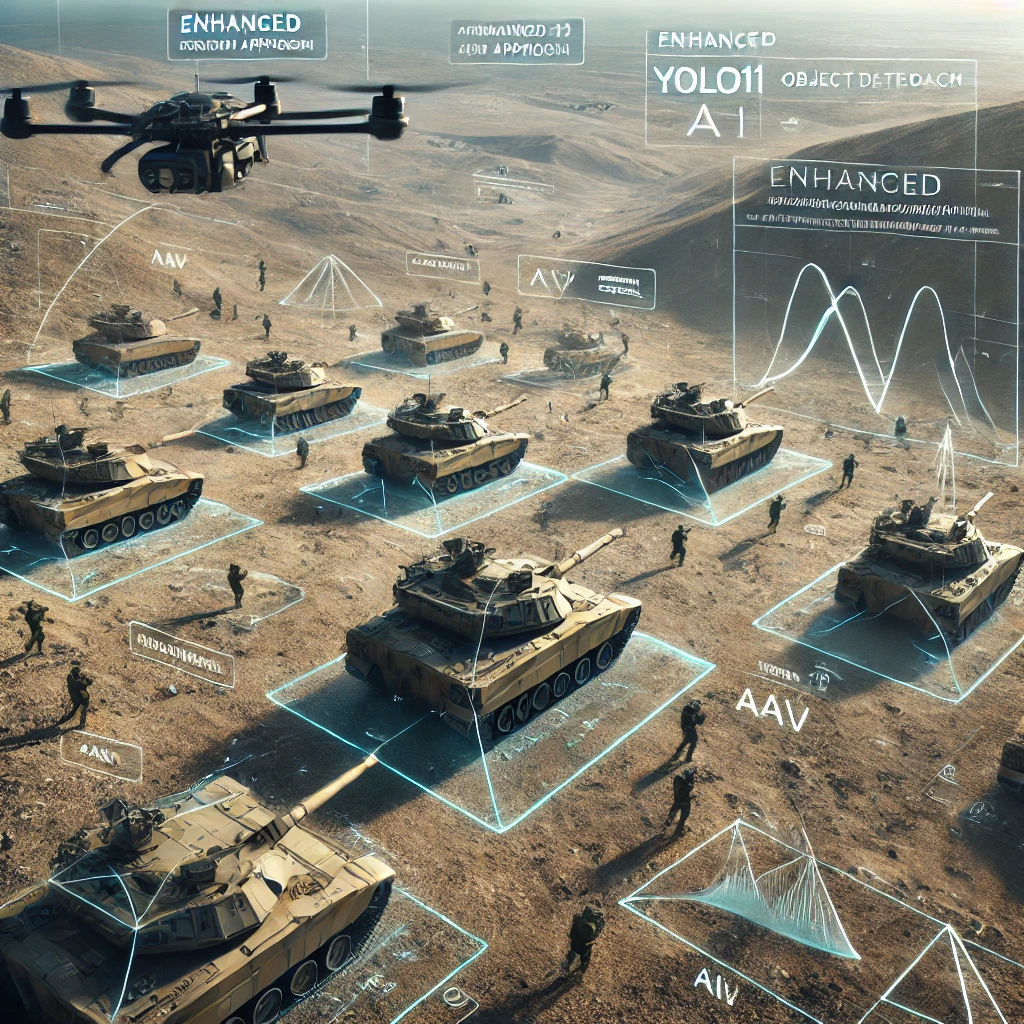Object prediction and detection of ground-based weapon with an improved YOLO11 approach
Focusing on assumptions underlying operational environments and UAV-captured features related to PLZ-05 Self-Propelled Howitzer
DOI:
https://doi.org/10.37944/jams.v7i3.256Keywords:
ground-based weapon systems, self-propelled Howitzer, trajectory prediction, YOLOv11, object detectionAbstract
The utilization of UAV-based detection technologies in ground weapon system analysis plays a crucial role in supporting real-time tactical decision-making. While previous studies have primarily focused on improving the detection and classification performance of military objects using UAVs, the current study proposes a novel system that not only detects military objects in simulated UAV operational environments but also analyzes the elevation and azimuth angles of detected gun barrels. For object detection, the YOLO11 model was employed in conjunction with the BCEF loss function to enhance detection performance. The proposed system was validated across various environments using synthetically generated images simulating complex battlefield conditions, including rain, challenging terrain, and low-light environments. Even under these adverse conditions, the model demonstrated high detection accuracy and reliability. This study highlights the potential of UAV-based object detection technology as a tactical decision-making support tool, extending its utility from reconnaissance and identification to broader operational roles. Future research need to further evaluate the performance of the proposed model with experimental validation in real-world UAV operational conditions, emphasizing real-time data collection and analysis frameworks.
Metrics
References
Barros, J. P., Reis, J., Melão, N., & Cavalieri, A. (2024). Key features and applications of military drones: a case study from the Portuguese military ground forces. Journal of Defense Analytics and Logistics, 8(2), 179-201. https://doi.org/10.1108/jdal-07-2024-0014
Chang, J. O. (2022). A Study on the Prediction of Future Warfare Changes and the Development Direction of the R.O.K. Army: Focusing on the relationship between war components and forms of war. Korean Journal of Military Art and Science, 78(3), 1-28. https://doi.org/10.31066/kjmas.2022.78.3.001
Creswell, A., Bharath, A. A., & Vedaldi, A. (2017). On denoising autoencoders trained to minimise binary cross-entropy. arXiv. https://arxiv.org/abs/1708.08487
Gupta, C., Gill, N. S., Gulia, P., & Chatterjee, J. M. (2023). A novel finetuned YOLOv6 transfer learning model for real-time object detection. Journal of Real-Time Image Processing, 20, 1-19. https://doi.org/10.1007/s11554-023-01234-5
Hwang, J. Y., Choi, B. A., Lee, J. H., & Bae, J. H. (2021). A Study on Transfer Learning-based Ensemble Model for Classification of Maneuver Weapon System. Journal of Korean Institute of Information Technology, 19(12), 1-10. https://doi.org/10.14801/jkiit.2021.19.12.1
Kim, D. B., & Kim, H. S. (2023). Development and Technological Strategy of Intelligent Ground Manned-Unmanned Composite Combat Systems: Focused on Future Ground Combat Systems. Journal of the Korea Association of Defense Industry Studies, Journal of Korean Institute of Information Technology, 30(3), 59-67. https://doi.org/10.52798/KADIS.2023.30.3.5
Kim, M. G., Shin, I. T., & Lee, J. G. (2023). A Study on the Devel opment Direction of Next Generation Drone Through Analysis of the Role of Drones Used in Warfare : From Gulf War to Ukraine War. Journal of the Korea Academia-Industrial cooperation Society, 24(10), 656-664. https://doi.org/10.5762/KAIS.2023.24.10.656
Kim, M. W., & Ma, J. M. (2023). Determining the Scal e of Mil itary Echel on Using Deep LearningBased Object Detection and Tracking Techniques. Journal of Korea Academia-Industrial cooperation Society, 24(5), 441-449. https://doi.org/10.5762/KAIS.2023.24.5.441
Lee, S. H., & Baek, S. N. (2020). Effects of the Technological and Individual Characteristics of Army Tactical Command Information System on Situation Awareness and Decision Making. Journal of The Korean Operations Research and Management Science Society, 45(2), 25-42. https://doi.org/10.7737/JKORMS.2020.45.2.025
Lee, W. H. (2021). Enabling reliable UAV control by utilizing multiple protocols and paths for transmitting duplicated control packets. Sensors, 21(9), 3295. https://doi.org/10.3390/s21093295
Lim, S. G, & Kang, D. S. (2021). Identifications and Evaluation of Tank Nationality using YOLO Algorithm. KIISE Transactions on Computing Practices, 27(12), 555-562. https://doi.org/10.5626/KTCP.2021.27.12.555
Lin, T.-Y., Goyal, P., Girshick, R., He, K., & Dollar, P. (2017). Focal loss for dense object detection. arXiv. https://arxiv.org/abs/1708.02002
Pan, S. J., & Yang, Q. (2010). A survey on transfer learning. IEEE Transactions on Knowledge and Data Engineering, 22(10), 1345-1359. https://doi.org/10.1109/TKDE.2009.191
Park, S. J., & Jin, H. S. (2020). Classification Type of Weapon Using Artificial Intelligence for Counter-battery RadarPaper Title. Journal of IKEEE, 24(4), 921-930. https://doi.org/10.7471/ikeee.2020.24.4.921
Redmon, J., & Farhadi, A. (2018). YOLOv3: An Incremental Improvement. arXiv preprint arXiv: 1804.02767. https://doi.org/10.48550/arXiv.1804.02767
Redmon, J., Divvala, S., Girshick, R., & Farhadi, A. (2016). You only look once: Unified, real-time object detection. Proceedings of the IEEE Conference on Computer Vision and Pattern Recognition (CVPR), 779–788. https://doi.org/10.1109/CVPR.2016.91
Shorten, C., & Khoshgoftaar, T. M. (2019). A survey on image data augmentation for deep learning. Journal of Big Data, 6(60). https://doi.org/10.1186/s40537-019-0197-0
Stocker, C., Bennett, R., Nex, F., Gerke, M., & Zevenbergen, J. (2017). Review of the current state of UAV regulations. Remote Sensing, 9(5), 459. https://doi.org/10.3390/rs9050459
Tan, M., & Le, Q. (2019). EfficientNet: Rethinking model scaling for convolutional neural networks. Proceedings of the 36th International Conference on Machine Learning, 6105-6114.
Vasavi, S., Raj, G. H., Sahithi, T., & Suhitha, Y. (2023). Onboard processing of drone imagery for military vehicles classification using enhanced YOLOv5. Journal of Advances in Information Technology, 14(6), 1221-1229.
Yaseen, M. (2024). What is YOLOv8: An in-depth exploration of the internal features of the next-generation object detector. arXiv preprint. Retrieved from https://arxiv.org/abs/2408.15857
Yuk, S. M. & Cho, Y. H. (2023). Research Trends on Deep Learning-based Image Detection of Weapon Systems in National Defense. 1-3. Journal of Korea Academia-Industrial cooperation Society Spring conference.

Downloads
Published
How to Cite
Issue
Section
License
Copyright (c) 2025 Journal of Advances in Military Studies

This work is licensed under a Creative Commons Attribution 4.0 International License.

This work is licensed under a Creative Commons Attribution 4.0 International License.

이 저작물은 크리에이티브 커먼즈 저작자표시 4.0 국제 라이선스에 따라 이용할 수 있습니다.






